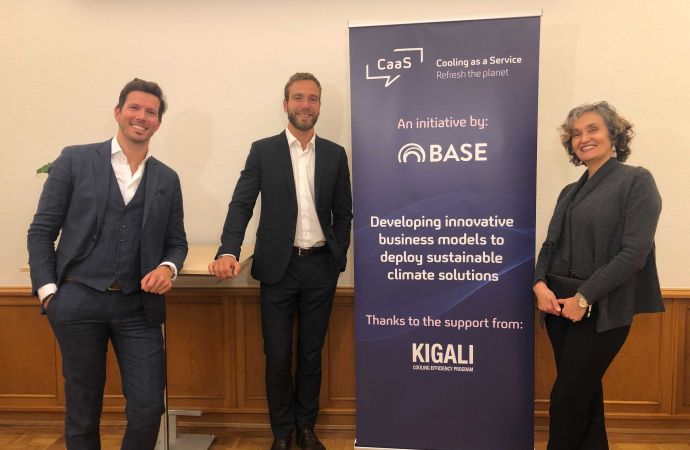The global event offered multiple examples of cooling-as-service facilitating installations of energy-efficient systems.

The BASE team behind the scenes, from left: Dimitris Karamitsos, Thomas Motmans, and Carla Della Maggiora.
The first Cooling-as-a-Service (CaaS) E-Summit, held on December 1, showed the revolutionary nature of the CaaS business model and its potential to scale up sustainable cooling and contribute to a net-zero built environment.
Cooling-as-a-service is a business model by which end users affordably pay for sustainable cooling systems on a pay-for-service model, without the burden of making large up-front CAPEX investments. It is particularly helpful in the developing world.
With 1,141 registrations from 82 countries, 50 speakers, and more than 16 hours of content, the online event shared the experiences and expertise of stakeholders throughout the value chain – from investors to technology providers and end users. The areas of focus were Southeast Asia (ASEAN), Africa, and Latin America and the Caribbean (LAC). (See the speaker agenda and more info on the speakers.)
“The Global CaaS E-Summit event highlighted the benefits of servitization as a way to bring energy-efficient cooling systems to the market, while reducing waste in the industries taking part and generating value for the stakeholders involved,” said Thomas Motmans Sustainable Energy Financial Specialist at the Basel Agency for Sustainable Energy (BASE), organizer and host of the event.
BASE, along with the Kigali Cooling Efficiency Program (K-CEP), manages the CaaS Initiative, which has been working on contracts, pricing models marketing material and events to support the implementation of CaaS projects. The initiative is supporting projects in Asia, Africa, and Latin America. shecco, publisher of this website, is a supporting partner of Cooling as a Service Initiative.
The E-Summit’s speaker program ran from 9 am CET to 8:30 pm CET to accommodate the ASEAN, African and LAC time zone, with specific sessions tailored to each region at an appropriate time. The afternoon sessions have been translated to Spanish and uploaded on the virtual platform.
The platform will stay online as a virtual library for one year. Previous and new attendees can log into the event here. New attendees can register by using the code “CaaS!”.
Linking sustainability to profit
The E-Summit program provided a comprehensive overview of how the CaaS model works, where it has been applied, and what the future of servitization looks like.
The day kicked off with Dan Hamza-Goodacre, Non-Executive Director of the Kigali Cooling Efficiency Program (KCEP) and a member of the COP26 Champions Team, highlighting the important role that cooling plays. He explained that CaaS can remove the burden of cooling from the end user to the benefit of all – including the climate. He showed the clear trend towards servitization worldwide – not just in the cooling sector.
Dave Mackerness, Leader of the Customer Success Team at Kaer, CaaS provider of air conditioning, delivered a speech on the disruptive business model and how it strongly benefits customers, business growth and sustainability. “CaaS links sustainability to profit,” said Mackerness. “And if you want to put sustainability at the forefront of any organization – if you can link it to profit, that’s your best bet.”
The first case study panel shared experiences from CaaS projects successfully implemented in Africa and India. Four technology providers discussed how they have been applying the CaaS model in their regions, highlighting the benefits and talking about the challenges they faced along the way. Panelists echoed that there is great potential to deploy sustainable cooling solutions in these regions, but there are market barriers including higher upfront investments, lack of trust in the performance of new technology, and prioritization of investments in core business activities. CaaS offers a solution to this challenge.
Three parallel sessions followed, looking deeper into the toolkit and the mechanics of the model, the investor’s perspective, and the end-user perspective. On the investment side, attendees heard how the concept of servitization has been around for a long time and that standardization of contracts is very important. Two end users – a real estate developer operating a CaaS project in India to a small-scale pay-per-use user in Nigeria –showed what a difference CaaS makes in their day-to-day lives.
A very topical session on CaaS and COVID-19 vaccine distribution followed, uniting the perspectives throughout the value chain on one panel moderated by subject matter expert Professor Toby Peters from the University of Birmingham, U.K. A lack of infrastructure, particularly in relation to the cold chain, was highlighted as a challenge for vaccine distribution, as well as an opportunity to transition to more climate-friendly refrigeration equipment. That is where CaaS comes in.
“In the vaccine distribution cold chain, cooling-as- a-service is enabling state-of-the-art technologies (both on the equipment and on the data side) to be combined to bring the right solution to the end customer,” summarized Dimitris Karamitsos, Senior Energy Efficiency Business Developer Specialist at BASE, in his moderator’s wrap-up of the session.
The next session included five experts looking at servitization models such as heating, lighting and efficiency as a service. A clear trend towards clients wanting services instead of assets was highlighted. The demand is there and servitization allows for more energy-efficient, sustainable solutions to be employed, they said.
The afternoon session (also with five speakers) echoed this message, looking more specifically at how servitization is transforming businesses. “The 2020s will be the era of product-as-a-service models for sustainable development. said Tomas Nauclér, Senior Partner at McKinsey & Company.
“We will see it in the whole building space, including heating and cooling. We look forward to this business model being developed even faster. We love what you’re doing in cooling-as-a-Service.”
Combating climate change
The second part of the E-Summit kicked off at 3:15 pm CET, which enabled guests from the LAC region to connect as well. The opening session looked at the role of cooling in combating climate change, and more specifically at CaaS as a game-changer for this industry. Jessica Brown, Executive Director at K-CEP, described how well CaaS is positioned to ensure cooling is delivered in clean and efficient solutions. Iain Campbell, Senior Fellow at the Rocky Mountain Institute (RMI) stressed the importance of looking at life-cycle costs and not just upfront expenditure – one of the key benefits the CaaS model offers.
This was followed by an interview with Jigar Shah, Co-founder of Generate Capital and SunEdison, moderated by Daniel Magallón, CEO of BASE. Shah shared his experience with the solar industry and spoke about applying these lessons to the cooling sector. He sees a clear opportunity in focusing on the market sectors where end users are desperate to replace outdated equipment but have no CAPEX to finance an upgrade. Here, CaaS will accelerate the adoption of natural refrigerants and energy-efficiency equipment, according to Shah. He spoke very highly of the CaaS Initiative: “I appreciate the wonderful work that you are doing in inspiring and promoting this concept [CaaS] because I think it is critical to accelerating the use of green refrigerants and high energy-efficiency solutions for heating, ventilation and air conditioning.”
The afternoon’s end-user session included five speakers and was moderated by shecco’s CEO Marc Chasserot, who brought the natural refrigerant perspective. Perspectives were also shared from Dominika Czerwinska, Director of Memberships and Regional networks from the World Green Building Council (WGBC); Rafael Echevarne, Director General at The Airport Council International from LAC; Andrea Fernández, Engineering Manager at Gentor (a building developer implementing CaaS); and Andre Snyman, General Manager at Lynca (a CaaS end user in South Africa).
Czerwinska from the WGBC particularly spoke about the role of this business model in achieving a net-zero future. “This pairing of delivering on efficiency while removing barriers to the uptake is what makes CaaS and the servitization of buildings such a really powerful solution for helping the industry reach our net-zero targets,” she said. Snyman from Lynca outlined how CaaS enabled the company to retrofit its meat processing operation with natural refrigerants powered by solar, while reducing operating expenses linked to cooling by more than 20%.
A six-speaker case study panel followed, looking at implementing CaaS at a major Caribbean University in Grenada; commercial buildings in Costa Rica and Argentina; the agricultural cold chain in India; and even in sustainable transport refrigeration. The potential of the CaaS model within the scope of post-COVID-19 recovery was mentioned on various occasions. “We’ve seen a significant growth for the model, and we expect that to grow further in the next years, and we believe this is an important model in the recovery [from] the pandemic,” said Alfredo Nicastro Senior VP of Global Operations at MGM Innova Group.
The day concluded with the three moderators from BASE urging attendees to take action and join the servitization revolution. “We hope that now you have no more doubt about the fact that cooling-as-a-service is the most sustainable way to cool buildings and operate businesses!” said Motmans.
The free-to-attend E-SUmmit was hosted on the Swapcard platform, giving attendees the opportunity to network and engage with anyone else in attendance, including the speakers. The sessions were very interactive with great participation from the audience by means of engaging in polls and posting questions and comments to the speakers.
Related stories


